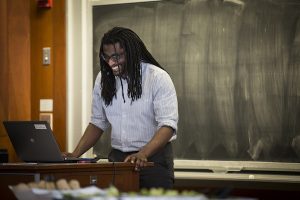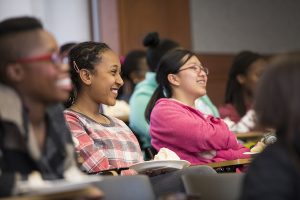By Sydney Lester
Computer scientist and electrical engineer John Nwagbaraocha of MIT Lincoln Laboratory visited MIT’s Cambridge campus on April 11 and spoke to local high school students about discovering his passions, science in popular culture, and harnessing the power of plasma. His talk was part of the Lunchtime Leadership Series for students in Saturday Engineering Enrichment and Discovery (SEED) Academy, a four-year academic enrichment program for high school students from Boston, Cambridge and Lawrence, Massachusetts.

Electrical engineer and computer scientist John Nwagbaraocha‘s childhood interests in science fiction eventually led him to a career working with plasma.
“I was pretty much a nerd.”
During his talk, Nwagbaraocha says he fell for science as a child, like most of the ninth through twelfth graders in the audience. “Around five, I realized I was pretty much a nerd,” he said. The themes and characters he saw on television and in comic books shaped his interests, such as concepts from science fiction. Like the local students participating in SEED Academy for their four years of high school, Nwagbaraocha sifted through career options before arriving at his destination. He says his love for science and engineering sparked when he found a concept that excited him.
“I wanted to do one thing, and that was to build a robot from scratch,” said Nwagbaraocha. So as a young engineer, he entered a robotics competition. He had programmed a robot to complete a series of movements to demonstrate his engineering skills, but his robot began to run out of battery charge during his presentation. He struggled to find a solution as his robot began to move backwards to its home base, just like Nwagbaraocha programmed it to do in the event of a low battery. “It had proximity centers on the front and back, and sonar beacons so it would know where its home was,” he says. Even with the hiccup, Nwagbaraocha’s “over-engineered” robot impressed his audience and pushed him toward electrical engineering.
His interest in robotics was only one of the factors that led to Nwagbaraocha’s pursuit of a career in engineering and science. “My parents were two of the biggest influences on my life,” said Nwagbaraocha. Popular culture also inspired and first taught him about engineering, specifically, the character Dwayne Wayne from the sitcom A Different World. “[Dwayne Wayne] was the first time I saw a black guy as an engineer,” Nwagbaraocha said. “I had never seen an engineer.”
His interests grew as he began to research electrical engineering and learn about the different types of science and engineering careers. Engineer and inventor Nikola Tesla — developer of the modern alternating electric current — and science fiction inspired Nwagbaraocha.
Fact from fiction
“Somewhere in the mid-’90s, I wanted to take things from science fiction and make them into reality,” said Nwagbaraocha. “I was fifteen, combing through books in the library, [on topics such as] electromagnetism.” He got his chance to fulfill this desire in graduate school when he “fell in love with plasma” and decided to devote his thesis to the fourth state of matter.
“It blew my mind that there was a fourth state,” said Nwagbaraocha. “I like to think of it as a state of matter that is excited and happy [because] it has positively and negatively charged ions.”
Nwagbaraocha talked to the students about the three energy levels of plasma, which are low, medium and high. Examples of low energy plasma include television screens and neon signs. “Plasmas you can touch,” according to Nwagbaraocha. At the other end of the spectrum are high-energy plasmas, which are too hot for humans to touch, such as stars and other gaseous bodies in space.
Nwagbaraocha now works as a project manager at the MIT Lincoln Laboratory, where he seeks out new ideas to explore through future projects and directs his team in the development of new technology. Although most of his work at Lincoln Laboratory is confidential, he discussed one of his favorite projects, which involved directing his team in creating a game for analysts.
SEED Life Mastery instructor Jacqueline Nkuebe asked Nwagbaraocha about an average day at MIT Lincoln Laboratory. “Right now, I’m a project manager. Communication is one of the biggest parts, putting fires out before they occur.” Along with managing his team, Nwagbaraocha seeks out new ideas for them to take on at the lab. “Then I do the fun part,” he said. “I’m researching on Ciphernet, looking up names, scouring things to figure out how I can create new projects.”

SEED Academy students responded positively to Nwagbaraocha’s love of Star Trek and interesting work as a project manager at MIT Lincoln Laboratory.
Flying cars and light sabers
SEED students were excited by Nwagbaraocha’s work with plasma and expressed curiosity about the specifics. “When you said you wanted to turn science fiction into reality, I realized the plasma thruster is like a phaser [from Star Trek],” said one SEED student.
When asked about other technologies he wanted to see developed, Nwagbaraocha responded with “teleportation, flying cars and light sabers.”
SEED Life Mastery instructor Ryan Marnane asked Nwagbaraocha about the relationship between the arts and engineering, a question that students grapple with in Marnane’s course. Nwagbaraocha’s answer championed studying the arts in tandem with science and engineering. “I thought I would be a science fiction writer or comic artist. You have to have the ability to think outside the box,” he said. “If you have a good imagination, you will become a good engineer.”
One SEED student asked what project Nwagbaraocha would take on if he had access to unlimited resources. “We need to get away from fossil fuels, so fusion is a good idea,” he said, explaining that he would fund a group of scientists to develop fusion technology in order to replace fossil fuels. “You just need to get the right minds in the right room.”
In closing, Nwagbaraocha gave the students career advice. “Find something you’re really interested in during your journey of discovery,” he said. “You may find something unexpected.”